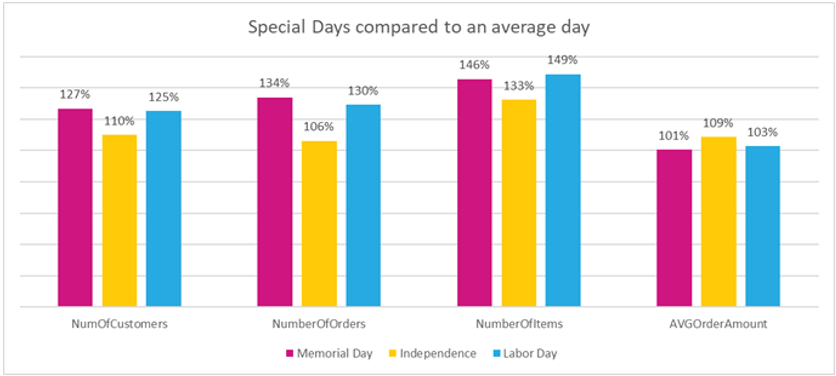Every holiday occasions sales, though some have greater effects than others, and Labor Day is anticipated to be one of those bigger days. According to Adobe’s Digital Dollar Report, this year’s Labor Day is expected to reach the $2 billion mark in sales.
What marketers can do to capitalize on these occasions is not just to offer the usual promotional pricing but to engage customers by reaching out to them in a data-driven and emotionally intelligent way.
The data that Optimove pulled up on holiday sales indicates Labor Day, like Memorial Day, enjoys a marked lift in sales. While the Fourth of July does occasion an increase of nine percent over an average order, which is ahead of Labor Day’s three percent and Memorial Day’s one percent, it falls behind other key measurements.
Holiday data
The breakdown is as follows (see graph above):
- Increase in number of customers v. an average day: Memorial Day (27 percent) and Labor Day (25 percent) beat out Independence Day (10 percent)
- Increase in number of items v. a normal day: Memorial Day (46%) and Labor Day (49%) beat out Independence Day (33 percent)
- Fewer new faces on July 4: Independence Day brings in fewer new customers (26%) than Memorial Day (30 percent).
To drill down further into Labor Day specifically, Optimove analyzed 6 brands with 3.5M customers, to identify relevant find shopping behavior. They concluded:
- Labor Day is a huge shopping day — and a big opportunity for retailers. Looking at the average distribution of customers in September, Labor Day sees the average number of customers is 25 percent higher than the yearly average
- The average number of orders and items increases significantly. That came to 30 percengt higher, and the number of items purchased was a massive 49 percent higher — nearly double an average day.
Pini Yakuel, Optimove’s CEO and founder, spoke to me about the significance of the data. It’s quite likely that the holidays that mark the beginning and the end of the summer season see greater increases because people do think about what they need to gear up for the upcoming season around these days, he explained. What Labor Day has going for it is not just an association with a shift to fall, but with back-to-school, and all the stuff students will need when returning to classes and dorms.
Conversation starters
But any holiday can be used as a springboard for connecting effectively with customers. “Relationship marketing looks for reasons to start a conversation,” said Yakuel. “Holidays provide that reason.”
That doesn’t mean that everyone is getting the same conversation. On the contrary, Yakuel stresses the need to customize messages to be sure they resonate with the intended target. “Not just one campaign but something that could be divided into multiple campaigns to fit individual customer personas,” he said.
That’s where data comes in, in identifying who should get what message. For example, there may be one type of message crafted for those who would respond to patriotic themes or sentimental values. Those conversations can then serve to attract new customers, incentivize existing ones, or just foster greater feelings of loyalty.
Building on that, Yakuel said, “it’s possible to construct individualized content around the holiday that is related to brand with personalized variation both from the data and content perspective.” Bearing the data on individuals also means appealing to their shopping tendencies. For example, some buy when lured by price and others when they need replenishment.
As more customers make purchases on these holidays, it is an opportune time for brand to acquire new customers as a result of their data-driven conversations. In fact, Optimove found nearly half (47 percent) of shoppers over Memorial Day weekend were first-time customers for the brand.
However, the “cherry-picker” customer who comes in only for a big discount rarely turns into a truly acquired customer. Optimove warns that, even though discounts are expected for holiday shopping, brands should consider the consequences. “Customers offered discounts of 30% or more are actually less likely to buy from brand again.”







